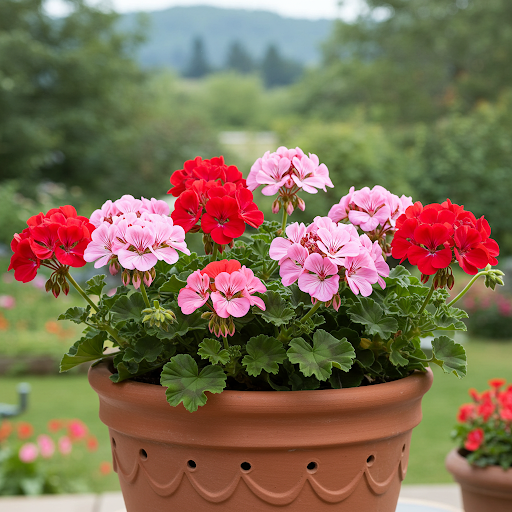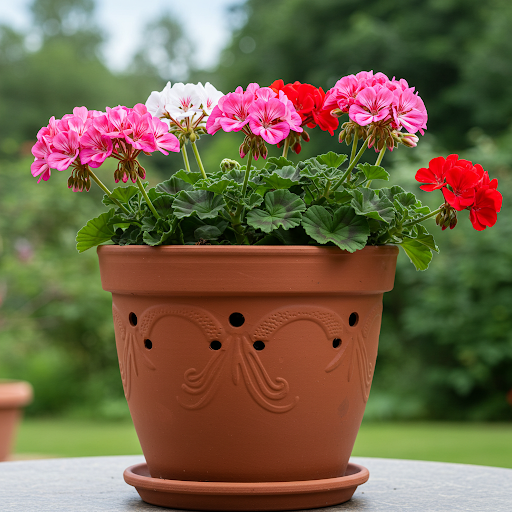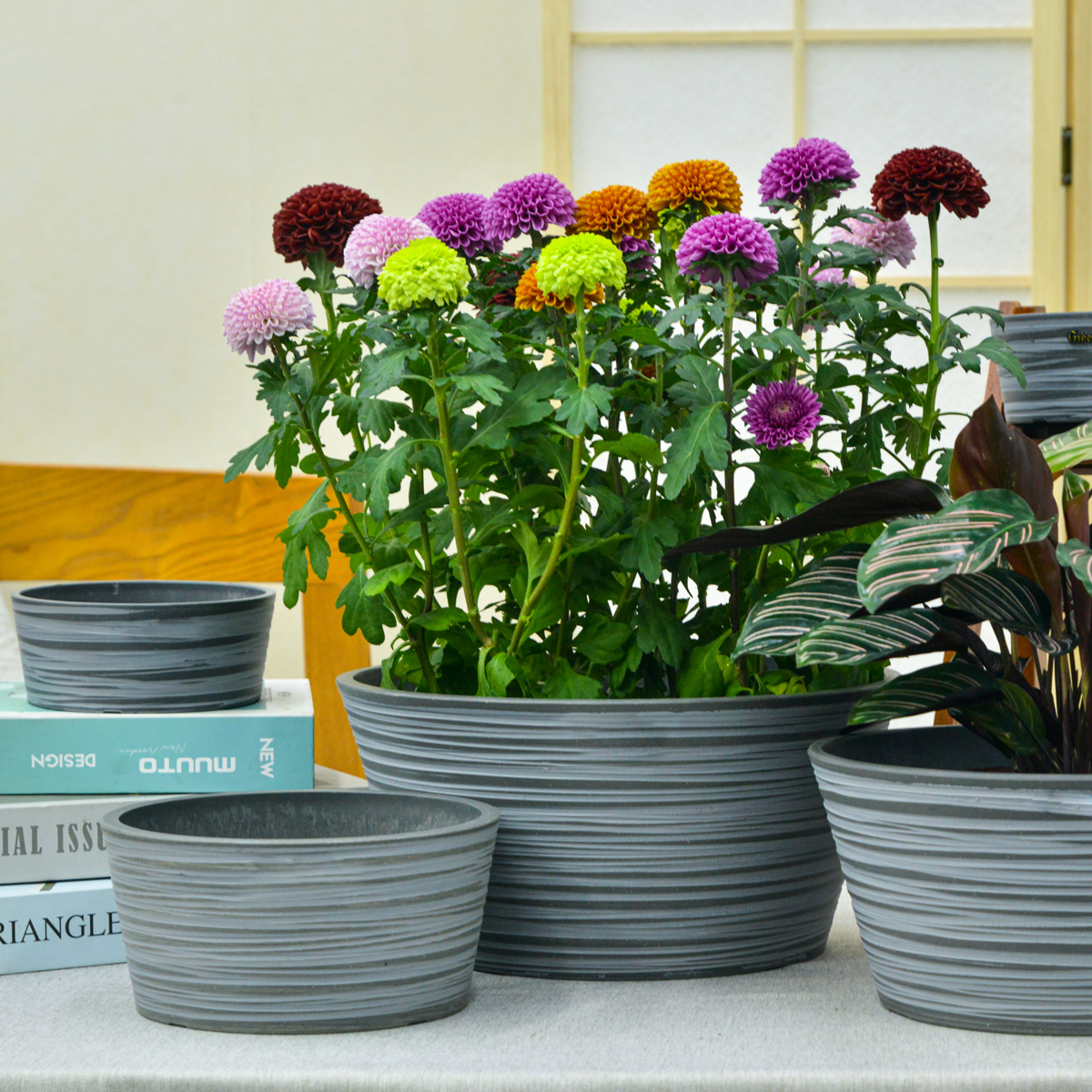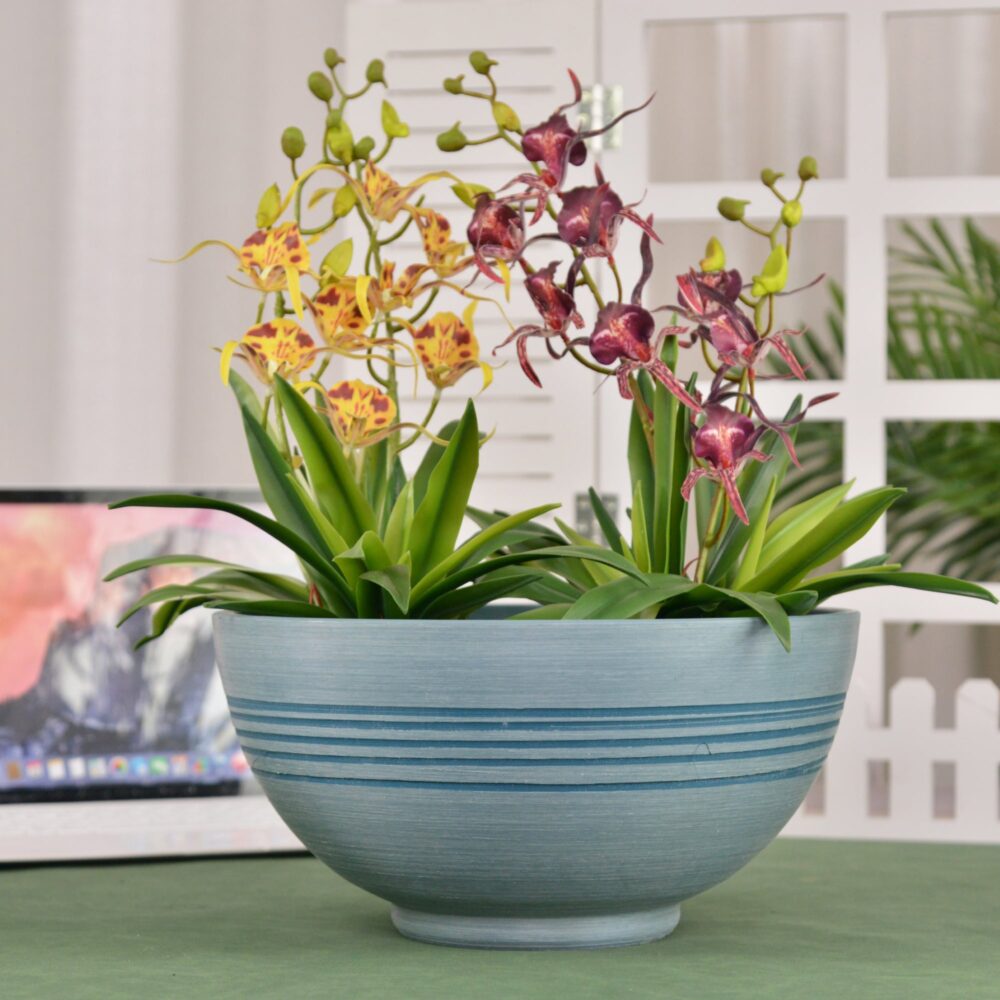Geraniums in Pots: The Ultimate Guide to Growing Pelargoniums Outdoors
Want to bring classic charm and vibrant color to your patio, balcony, or garden containers? Geraniums, botanically known as Pelargoniums, are a beloved and enduring favorite for outdoor container gardening, prized for their cheerful blooms, diverse foliage, and easy-care nature. From classic zonal geraniums to elegant regal types and trailing ivy geraniums, there’s a geranium for every pot and style. This comprehensive guide will provide you with everything you need to know to grow geraniums successfully in outdoor pots, from selecting the best varieties and containers to mastering essential care techniques for a season-long display of geranium beauty.

Geraniums
What are Geraniums (Pelargonium)?
Geraniums, scientifically classified as Pelargonium, are a genus of flowering plants belonging to the family Geraniaceae. Often referred to as “geraniums” in common usage, they are distinct from true geraniums (Geranium genus), which are also known as “cranesbills.” Pelargoniums are native to Southern Africa and are popular annual bedding plants (though they can be perennial in frost-free zones) celebrated for their clusters of brightly colored flowers and varied foliage, which can be zonal-patterned, ivy-leaved, or scented. Geraniums come in a wide array of colors including red, pink, white, salmon, orange, and bi-colors, and various flower forms (single, double, semi-double). They are broadly categorized into types such as Zonal Geraniums, Ivy Geraniums, Regal Geraniums, and Scented Geraniums. Geraniums are cherished for their long blooming season, drought tolerance, vibrant colors, and ability to attract butterflies, making them a quintessential choice for adding classic beauty and low-maintenance appeal to outdoor containers.
Are Geraniums (Pelargonium) Good for Outdoor Pots?
Yes, Geraniums (Pelargonium) are exceptionally well-suited for outdoor pots and container gardening. Their upright, mounding, and trailing growth habits make them ideal for filling pots, window boxes, and hanging baskets with vibrant color. Geraniums thrive in sunny locations and bloom reliably throughout the summer and into fall, providing a continuous and cheerful display in containers. Their adaptability, drought tolerance, and wide variety of types make them a versatile and forgiving choice for container gardens of all styles.
Ideal Growing Conditions for Geraniums (Pelargonium) in Pots:
- Types of Geraniums for Pots: All types of geraniums can be grown in pots, but some are especially popular and well-suited for container displays. Consider these classic and charming geranium types for your pots:
- Zonal Geraniums: ( Pelargonium x hortorum) – The most common and classic geranium type, known for their distinctive “zone” or band of color on their leaves and upright, mounding growth habit. Available in a vast array of colors and flower forms. Excellent for general container planting, window boxes, and massed displays.
- Ivy Geraniums: (Pelargonium peltatum) – Trailing or cascading growth habit with glossy, ivy-shaped leaves. Perfect for hanging baskets, window boxes, and spilling over the edges of pots. Known for their weather resistance and continuous blooms.
- Regal Geraniums: (Pelargonium x domesticum) – Also known as Martha Washington geraniums, prized for their large, showy, often bi-colored flowers with ruffled petals. More sensitive to heat than zonal or ivy geraniums, best in partial shade or morning sun locations. Elegant and striking in pots.
- Scented Geraniums: (Pelargonium species and hybrids) – Grown for their fragrant leaves, which release scents when brushed, ranging from citrus, mint, rose, chocolate, and more. Flowers are typically smaller and less showy, but foliage is highly aromatic and interesting. Great for sensory gardens and mixed herb/flower containers.
- Light: Geraniums thrive in full sun to partial shade. For best flowering and robust growth, they prefer at least 6-8 hours of direct sunlight per day. In very hot summer climates, especially for Regal geraniums, partial afternoon shade can be beneficial to prevent scorching. Insufficient light will result in fewer blooms, leggy growth, and less vibrant colors. Choose a sunny to partially sunny location for your geranium containers.
- Soil: Geraniums need well-draining soil to prevent root rot. Use a high-quality potting mix specifically formulated for containers or flowers. Avoid using garden soil in pots, as it can become compacted and poorly drained. A good potting mix will provide the necessary drainage and aeration for healthy root growth. You can amend potting mix with perlite or vermiculite to further improve drainage, especially for very dense mixes.
- Watering: Geraniums prefer slightly drier conditions and are relatively drought-tolerant once established. Water thoroughly when the top inch or two of soil feels dry. Allow the soil to dry out slightly between waterings. Water deeply until water drains out of the drainage holes. Avoid overwatering and soggy soil, which can lead to root rot. Geraniums are more tolerant of underwatering than overwatering. Water less frequently in cooler weather or shade. Check soil moisture regularly and adjust watering frequency based on weather conditions and pot size. Water at the base of the plant to keep foliage dry and help prevent fungal diseases.
- Temperature: Geraniums are warm-weather plants and thrive in warm temperatures. They perform best in temperatures between 60°F to 80°F (15°C to 27°C). They are sensitive to frost and cold temperatures. Plant geraniums outdoors after the last frost in your area. While they can tolerate some heat, in extremely hot summer climates, especially for Regal geraniums, providing some afternoon shade can be beneficial.
- Fertilizer: Geraniums benefit from regular fertilization, but are not heavy feeders. Fertilize monthly during the growing season to encourage continuous blooming. Use a balanced liquid fertilizer (e.g., 10-10-10 or 20-20-20) diluted to half strength, or a fertilizer specifically formulated for flowering annuals. Avoid over-fertilizing, which can lead to excessive foliage growth at the expense of flowers.
Choosing the Right Pots for Geraniums (Pelargonium):
- Suitable Pot Types: Geraniums are adaptable to various pot types, including terracotta, ceramic, plastic, and hanging baskets. Consider these factors when selecting pot types for geraniums:
- Terracotta Pots: Porous, allow excellent aeration and drainage, and aesthetically classic, but dry out more quickly, requiring more frequent watering, especially in hot weather. Well-suited for zonal and scented geraniums.
- Ceramic Pots: Available in many decorative styles, retain moisture better than terracotta, and can add a decorative element to your container garden. Ensure good drainage. Good for regal and zonal geraniums.
- Plastic Pots: Lightweight, inexpensive, retain moisture well, available in various colors and styles. Choose good quality plastic pots that are durable and UV-resistant. Good for all geranium types, especially ivy geraniums in hanging baskets.
- Hanging Baskets: Ideal for ivy geraniums and trailing zonal geraniums, create cascading displays of color. Require frequent watering and fertilization due to their exposed nature and quick drying.
- Window Boxes: Excellent for displaying zonal, ivy, and regal geraniums on windowsills or railings. Choose boxes with good drainage and sufficient depth.
- Drainage: Excellent drainage is crucial for geraniums to prevent root rot. Ensure your chosen pot has drainage holes at the bottom. Avoid pots without drainage holes. You can elevate pots slightly to ensure drainage holes are not blocked. Adding a layer of gravel or pot shards at the base of the pot is generally not necessary if using a well-draining potting mix, but can be done for extra precaution in very heavy pots or mixes.
- Pot Size: Choose pot sizes appropriate for the type and number of geraniums you are planting. Geraniums generally prefer to be slightly root-bound, so avoid overly large pots.
- Individual Geraniums (Zonal, Regal, Scented): For a single zonal, regal, or scented geranium plant, a pot that is 6-8 inches in diameter is a good starting size. For larger, bushier plants, use 8-12 inch pots.
- Ivy Geraniums (Hanging Baskets & Pots): For ivy geraniums in hanging baskets or pots, choose containers that are 10-14 inches in diameter to allow for trailing growth and ample blooms.
- Mixed Geranium Containers: For planting multiple geraniums together or in mixed arrangements, use larger pots or containers, such as 12-18 inches or larger in diameter, or window boxes and long planters.
- Depth: Ensure pots are at least 6-8 inches deep to provide adequate root space for most geranium types. Deeper pots are better for larger zonal and regal geraniums.
- Color and Style: Choose pot colors and styles that complement your geranium blooms and your outdoor décor. Classic terracotta pots enhance the traditional charm of geraniums, while brightly colored or decorative ceramic pots can add a more contemporary or personalized touch.
Essential Care Tips for Thriving Geraniums (Pelargonium) in Outdoor Pots:
- Watering: “Water Thoroughly, Let Soil Dry Slightly”. Water thoroughly when the top 1-2 inches of soil feel dry. Allow the soil to dry out slightly between waterings. Avoid overwatering and soggy soil. Water less frequently in cool or cloudy weather.
- Sunlight: Provide Full Sun to Partial Shade. Place geranium pots in a location that receives at least 6-8 hours of direct sun, or partial shade in very hot climates (especially for Regal geraniums).
- Fertilizing: Feed Monthly During Growing Season. Fertilize monthly with a balanced liquid fertilizer or flowering plant fertilizer to encourage continuous blooming. Avoid over-fertilizing.
- Deadheading (Essential for Continuous Bloom): Deadhead spent or faded flowers regularly to encourage more blooms and keep plants looking tidy. Pinch or snip off dead flower heads right below the flower cluster, removing the entire flower stem down to the first set of leaves. Regular deadheading is crucial for prolific and continuous flowering in geraniums.
- Pruning (Shape and Maintain Size): Prune back leggy stems or overgrown geraniums to maintain a desired shape and size, and encourage bushier growth. You can prune back stems by about 1/3 in late spring or mid-summer if plants become too large or leggy.
- Pest and Disease Control: Geraniums are generally relatively pest and disease-resistant, but monitor for common pests like aphids, spider mites, geranium budworms, and geranium leafrollers. Botrytis blight (gray mold) and root rot can occur, especially in overly humid conditions or with poor drainage and overwatering. Ensure good air circulation, avoid overcrowding, water at the base of the plant, and treat any pest or disease issues promptly with insecticidal soap, horticultural oil, neem oil, or appropriate fungicides if necessary.
- Overwintering (Optional, in Colder Zones): Geraniums are not frost-hardy annuals in most zones, but can be overwintered indoors to save plants for the next season. Before the first frost, bring potted geraniums indoors to a cool, bright location (such as a sunroom or unheated garage). Cut back foliage by about 1/3, reduce watering significantly, and allow plants to go semi-dormant over winter. In late winter or early spring, increase watering and light, and fertilize to encourage new growth before moving plants back outdoors after the last frost. Alternatively, geraniums can be treated as annuals and replaced each spring.
Popular Geranium Cultivars for Pots (by Type):
- Zonal Geraniums: ‘Calliope Series’, ‘Caliente Series’, ‘Americana Series’, ‘Maverick Series’
- Ivy Geraniums: ‘Cascade Series’, ‘Tornado Series’, ‘Blizzard Series’, ‘Sugar Baby’
- Regal Geraniums: ‘Elegance Series’, ‘Mona Lisa Series’, ‘Imperial Series’, ‘Grand Prix’
- Scented Geraniums: ‘Citronella’, ‘Rose’, ‘Peppermint’, ‘Chocolate Mint’, ‘Lime’

Geraniums
In Summary:
Growing Geraniums (Pelargonium) in outdoor pots is a classic and rewarding way to add enduring beauty and vibrant color to your outdoor living spaces. Their easy-care nature, drought tolerance, and long blooming season make them a perfect choice for container gardeners of all levels. By providing full sun to partial shade, well-draining potting mix in pots with drainage, watering appropriately and allowing the soil to slightly dry between waterings, fertilizing monthly, and deadheading spent blooms, you can easily cultivate stunning geranium displays in pots and enjoy their cheerful charm all season long.
For more detailed botanical information and to explore the diverse world of Pelargonium varieties, you can visit the Wikipedia page on Pelargonium.
Important Note: Geraniums (Pelargonium) are considered mildly toxic to humans and pets if ingested in large quantities, potentially causing minor skin irritation or digestive upset. It’s advisable to keep plants out of reach of curious children and pets. The primary care challenges with geraniums in pots are ensuring good drainage to prevent root rot and regular deadheading to encourage continuous blooming. With these simple care practices, you can enjoy a season filled with the classic beauty of geraniums in your outdoor containers.**
Modern Plant Pots with Drainage – Indoor & Outdoor Use (6″ Widths)
By greenship-seo|2025-04-10T06:29:43+00:00February 6, 2025|Categories: Hand-carving Series|Tags: Decorative Flower Pots|
11THD
By greenship|2024-08-13T02:52:20+00:00August 13, 2024|Categories: Hand-carving Series|
KC2-11V
By greenship|2024-08-16T05:39:50+00:00August 16, 2024|Categories: Hand-carving Series|
k2-21G
By greenship|2024-08-13T06:17:26+00:00August 13, 2024|Categories: Hand-carving Series|
20VD
By greenship|2024-08-13T06:43:41+00:00August 13, 2024|Categories: Hand-carving Series|
13 inch Planter for Indoor Plants, Set of 2 Modern Decorative Plant Pots with Drainage Hole, Cute Bowl Shape Flower Pots
By greenship-seo|2025-04-10T07:41:46+00:00January 10, 2025|Categories: Hand-carving Series|Tags: Decorative Flower Pots, Self-Watering Pots|






